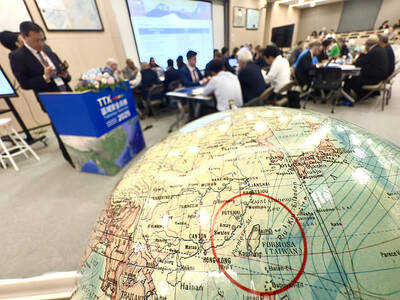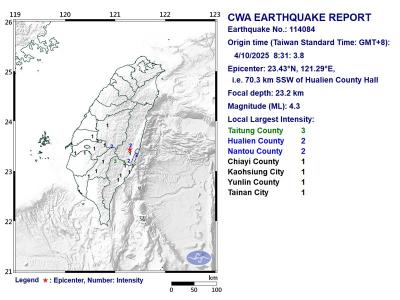Beijing is ramping up its cognitive warfare by aggregating negative news reports to stoke public discontent toward the government’s handling of the COVID-19 pandemic, security officials said on Tuesday.
By cherry-picking negative reports from Taiwanese media, then repackaging them and disseminating its version through new media, Chinese state media hopes to create the impression of widespread public discontent, officials said on condition of anonymity.
For example, China National Radio on Thursday last week aired a report that the Democratic Progressive Party government has been “selective” in its crackdown on misinformation to suppress news unfavorable to itself.
The state-run radio claimed that the government has only focused on clarifying negative stories about its handling of the pandemic, while turning a blind eye to its problems with response to the pandemic and vaccine procurement.
These comments were first broadcast on the new media platform “Watching the Taiwan Strait” (看台海) on WeChat, which is run by the state media company China Media Group, the officials said.
The platform aims to disseminate information across Chinese and foreign social media sites, including WeChat, Sina Weibo, Toutiao, Facebook, YouTube and Twitter.
Similar reports were then published by Chinese and some Taiwanese media outlets, they said.
This reveals how Beijing is using the pandemic to wage cognitive warfare on Taiwan, they added.
State-run media aggregates Taiwanese reports assailing the government’s pandemic policy — such as vaccine procurement, distribution and protection of local vaccine producers — and spins them to create a misleading narrative of public discontent, they said.
It then disseminates these reports on popular sites, with sensational headlines to improve their credibility and virality, they added.
The Chinese Communist Party regards new media as a tool for spreading propaganda, the officials said, adding that all propaganda departments from the central to local level use WeChat, Douyin, Toutiao, Watching the Taiwan Strait and other platforms.
Through traditional and new media, the departments can disseminate large amounts of information that are helpful to daily life and propagandistic, they added.
State-run media also use foreign social media platforms to spread misinformation, such as reports of mass cremations in Taipei’s Wanhua District (萬華), they said, urging Taiwanese to be alert to such false reports.

DEFENSE: The National Security Bureau promised to expand communication and intelligence cooperation with global partners and enhance its strategic analytical skills China has not only increased military exercises and “gray zone” tactics against Taiwan this year, but also continues to recruit military personnel for espionage, the National Security Bureau (NSB) said yesterday in a report to the Legislative Yuan. The bureau submitted the report ahead of NSB Director-General Tsai Ming-yen’s (蔡明彥) appearance before the Foreign and National Defense Committee today. Last year, the Chinese People’s Liberation Army (PLA) conducted “Joint Sword-2024A and B” military exercises targeting Taiwan and carried out 40 combat readiness patrols, the bureau said. In addition, Chinese military aircraft entered Taiwan’s airspace 3,070 times last year, up about

Taiwan is stepping up plans to create self-sufficient supply chains for combat drones and increase foreign orders from the US to counter China’s numerical superiority, a defense official said on Saturday. Commenting on condition of anonymity, the official said the nation’s armed forces are in agreement with US Admiral Samuel Paparo’s assessment that Taiwan’s military must be prepared to turn the nation’s waters into a “hellscape” for the Chinese People’s Liberation Army (PLA). Paparo, the commander of the US Indo-Pacific Command, reiterated the concept during a Congressional hearing in Washington on Wednesday. He first coined the term in a security conference last

A magnitude 4.3 earthquake struck eastern Taiwan's Hualien County at 8:31am today, according to the Central Weather Administration (CWA). The epicenter of the temblor was located in Hualien County, about 70.3 kilometers south southwest of Hualien County Hall, at a depth of 23.2km, according to the administration. There were no immediate reports of damage resulting from the quake. The earthquake's intensity, which gauges the actual effect of a temblor, was highest in Taitung County, where it measured 3 on Taiwan's 7-tier intensity scale. The quake also measured an intensity of 2 in Hualien and Nantou counties, the CWA said.

The Overseas Community Affairs Council (OCAC) yesterday announced a fundraising campaign to support survivors of the magnitude 7.7 earthquake that struck Myanmar on March 28, with two prayer events scheduled in Taipei and Taichung later this week. “While initial rescue operations have concluded [in Myanmar], many survivors are now facing increasingly difficult living conditions,” OCAC Minister Hsu Chia-ching (徐佳青) told a news conference in Taipei. The fundraising campaign, which runs through May 31, is focused on supporting the reconstruction of damaged overseas compatriot schools, assisting students from Myanmar in Taiwan, and providing essential items, such as drinking water, food and medical supplies,